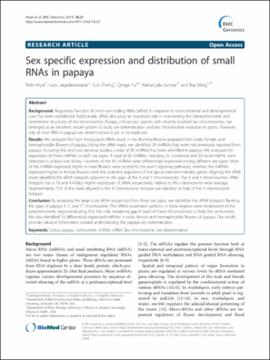| dc.contributor.author | Aryal, Rishi | |
| dc.contributor.author | Jagadeeswaran, Guru | |
| dc.contributor.author | Zheng, Yun | |
| dc.contributor.author | Yu, Qingyi | |
| dc.contributor.author | Sunkar, Ramanjulu | |
| dc.contributor.author | Ming, Ray | |
| dc.date.accessioned | 2019-08-21T22:01:25Z | |
| dc.date.available | 2019-08-21T22:01:25Z | |
| dc.date.issued | 2014-01-13 | |
| dc.identifier | oksd_aryal_sexspecificexpr_2014 | |
| dc.identifier.citation | Aryal, R., Jagadeeswaran, G., Zheng, Y., Yu, Q., Sunkar, R., & Ming, R. (2014). Sex specific expression and distribution of small RNAs in papaya. BMC Genomics, 15(20). https://doi.org/10.1186/1471-2164-15-20 | |
| dc.identifier.uri | https://hdl.handle.net/11244/321190 | |
| dc.description.abstract | Background: Regulatory function of small non-coding RNAs (sRNA) in response to environmental and developmental cues has been established. Additionally, sRNA, also plays an important role in maintaining the heterochromatin and centromere structures of the chromosome. Papaya, a trioecious species with recently evolved sex chromosomes, has emerged as an excellent model system to study sex determination and sex chromosome evolution in plants. However, role of small RNA in papaya sex determination is yet to be explored. | |
| dc.description.abstract | Results: We analyzed the high throughput sRNAs reads in the Illumina libraries prepared from male, female, and hermaphrodite flowers of papaya. Using the sRNA reads, we identified 29 miRNAs that were not previously reported from papaya. Including this and two previous studies, a total of 90 miRNAs has been identified in papaya. We analyzed the expression of these miRNAs in each sex types. A total of 65 miRNAs, including 31 conserved and 34 novel mirNA, were detected in at least one library. Fourteen of the 65 miRNAs were differentially expressed among different sex types. Most of the miRNA expressed higher in male flowers were related to the auxin signaling pathways, whereas the miRNAs expressed higher in female flowers were the potential regulators of the apical meristem identity genes. Aligning the sRNA reads identified the sRNA hotspots adjacent to the gaps of the X and Y chromosomes. The X and Y chromosomes sRNA hotspots has a 7.8 and 4.4 folds higher expression of sRNA, respectively, relative to the chromosome wide average. Approximately 75% of the reads aligned to the X chromosome hotspot was identical to that of the Y chromosome hotspot. | |
| dc.description.abstract | Conclusion: By analyzing the large-scale sRNA sequences from three sex types, we identified the sRNA hotspots flanking the gaps of papaya X, Y, and Yh chromosome. The sRNAs expression patterns in these regions were reminiscent of the pericentromeric region indicating that the only remaining gap in each of these chromosomes is likely the centromere. We also identified 14 differentially expressed miRNAs in male, female and hermaphrodite flowers of papaya. Our results provide valuable information toward understanding the papaya sex determination. | |
| dc.format | application/pdf | |
| dc.language | en_US | |
| dc.publisher | BioMed Central | |
| dc.rights | This material has been previously published. In the Oklahoma State University Library's institutional repository this version is made available through the open access principles and the terms of agreement/consent between the author(s) and the publisher. The permission policy on the use, reproduction or distribution of the material falls under fair use for educational, scholarship, and research purposes. Contact Digital Resources and Discovery Services at lib-dls@okstate.edu or 405-744-9161 for further information. | |
| dc.title | Sex specific expression and distribution of small RNAs in papaya | |
| osu.filename | oksd_aryal_sexspecificexpr_2014.pdf | |
| dc.description.peerreview | Peer reviewed | |
| dc.identifier.doi | 10.1186/1471-2164-15-20 | |
| dc.description.department | Biochemistry and Molecular Biology | |
| dc.type.genre | Article | |
| dc.type.material | Text | |
| dc.subject.keywords | carica papaya | |
| dc.subject.keywords | centromere | |
| dc.subject.keywords | miRNA | |
| dc.subject.keywords | siRNA | |
| dc.subject.keywords | sex chromosome | |
| dc.subject.keywords | sex determination | |
